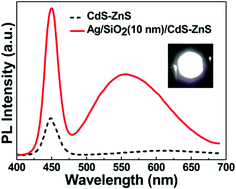Bright white-light emission from Ag/SiO2/CdS–ZnS core/shell/shell plasmon couplers
Abstract
Well-defined plasmon couplers (PCs) that comprise a Ag core overcoated with a SiO2 shell with controlled thickness, followed by a monolayer of CdS–ZnS core–shell quantum dots (QDs) were synthesized to modify the emission from trap-rich CdS–ZnS QDs by adjusting the distance between the QDs and Ag nanoparticles (NPs). When the thickness of the SiO2 shell was 10 nm, because the shell could effectively suppress the non-radiative energy transfer from the semiconductor QDs to the metal NPs and the localized surface plasmon resonance (LSPR) of the Ag NPs spectrally matched the emission peak of the CdS–ZnS QDs to bring about strong plasmon coupling, optimum enhancements of the surface state emission (SSE) (17 times) and band-edge emission (BEE) (4 times) were simultaneously realized and the SSE to BEE intensity ratio was increased to 55%. As a result, a bright white-light source with 1931 Commission Internationale d'Eclairage (CIE) chromaticity coordinates of (0.32, 0.34) was realized by the superposition of the two emissions. The experimental results from Ag/SiO2/CdSe–ZnS and the Ag/SiO2/CdS:Mn–ZnS core/shell/shell PCs indicated that suppressing the non-radiative decay rate (knr) was the underlying mechanism for plasmon coupling fluorescence enhancement.


 Please wait while we load your content...
Please wait while we load your content...